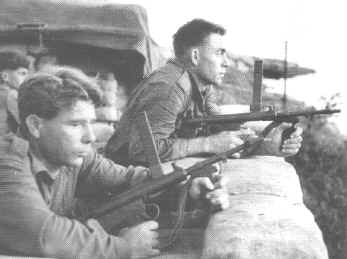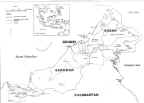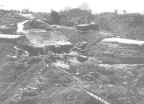|
In 1964, Indonesia
launched a campaign of confrontation against the newly-created
Federation of Malaysia, seeking to de-stabilise and ultimately to
destroy it. Most incursions were into Sarawak and Sabah, with a few into
mainland (Western) Malaysia.
Dawn 'stand-to', 3
RAR, Sarawak >>
By the end of that year, there were 21
British, Gurkha and Malaysian battalions, with supporting arms, deployed
in Borneo. |
 |
The Malaysian Government requested the commitment of
Australian troops to Borneo in January 1965, resulting in 3RAR and 102
Field Battery (then with the BCFESR), 1SAS Squadron and a number of
field and construction squadrons being deployed to Borneo. Further, 111
Light Anti Aircraft Battery, relieved later by 110 Battery, was deployed
to the Butterworth Air Base in Western Malaysia in case of Indonesian
air attack.
In the meantime, several
brigades of Indonesian regular troops had been moved from Java to
Kalimantan, opposite Sarawak and Sabah. Ultimately 22,000 regular
Indonesian troops including 12 infantry battalions , 4,000 irregulars
and 2,000 Clandestine Communist Organisation (CCO) operatives with some
24,000 Chinese sympathisers, were involved. The Indonesian incursions
into Sarawak and Sabah were in relatively small groups, often less than
platoon-level.
 |
<<
This map shows Sabah, Brunei and Sarawak on the Malaysian side of
the border and Kelimantan on the Indonesian side. |
The Commonwealth security
forces were deployed primarily in company bases within mutually
supporting gun range, patrols being mounted to secure intelligence, set
ambushes and to force the Indonesians to remain behind their own border.
3RAR served on operations from March to July 1965, and 4RAR April to
August 1966. 1SAS Squadron served from April to August 1965 and 2SAS
Squadron from March to July 1966.
As well as operations on
Borneo and the mainland of Malaysia, Australian troops, mainly from the
Pacific Islands Regiment, were engaged in intensive patrolling along the
only land border between Indonesia and Australian territory – in Papua
New Guinea. While there was only one shooting incident, the demands of
patrolling in such difficult terrain imposed a considerable drain on the
available pool of Australian officers and NCOs.
Confrontation formally
ended in August 1966. Australian Army casualties were seven KIA, six
WIA, with 10 non-operational deaths and 14 non-operational other
casualties
|




